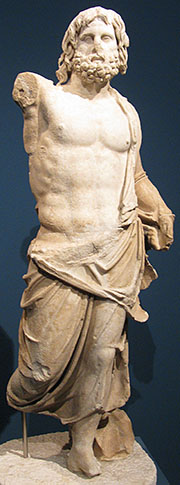This statue was made of Proconnesian marble [1] around 160 BC, during the reign of Eumenes II (197-159 BC). Found at the Great Altar of Zeus (the "Pergamon Altar" see gallery 2, page 23) among statues of tritons. The statue group decorated the roof (akroterion) of the altar. The god originally held a trident in his raised right hand and a dolphin in his left. The statue is now in the Pergamon Museum, Berlin, along with many other archaeological finds from Pergamon.
In comparison to the pugilistic statue of "Athena with the cross-banded aegis" on gallery 2, page 13, this statue makes the cruel sea god and seismic earth-shaker Poseidon (Ποσειδῶν), brother of Zeus, look rather beneficent. Although ancient writers did not shy away from describing the god's wrathful treatment of heroes such Odysseus, it seems that sculptors took no risks and preferred to present his grandeur.
According to Roman poet Ovid, it was Poseidon (known to the Romans as Neptune), who caused the Great Flood when his brother Zeus decided to destroy the first human race.
"Neptune himself strikes the ground with his trident, so that it trembles, and with that blow opens up channels for the waters.
Overflowing, the rivers rush across the open plains, sweeping away at the same time not just orchards, flocks, houses and human beings, but sacred temples and their contents. Any building that has stood firm, surviving the great disaster undamaged, still has its roof drowned by the highest waves, and its towers buried below the flood.
And now the land and sea are not distinct, all is the sea, the sea without a shore.
There one man escapes to a hilltop, while another seated in his rowing boat pulls the oars over places where lately he was ploughing. One man sails over his cornfields or over the roof of his drowned farmhouse, while another man fishes in the topmost branches of an elm.
Sometimes, by chance, an anchor embeds itself in a green meadow, or the curved boats graze the tops of vineyards. Where lately lean goats browsed shapeless seals play.
The Nereids are astonished to see woodlands, houses and whole towns under the water. There are dolphins in the trees: disturbing the upper branches and stirring the oak-trees as they brush against them. Wolves swim among the sheep, and the waves carry tigers and tawny lions. The boar has no use for his powerful tusks, the deer for its quick legs, both are swept away together, and the circling bird, after a long search for a place to land, falls on tired wings into the water.
The sea in unchecked freedom has buried the hills, and fresh waves beat against the mountaintops. The waters wash away most living things, and those the sea spares, lacking food, are defeated by slow starvation." [2]
"Virtuous and justice-loving" Deucalion and his wife Pyrrha are the only humans to survive the deluge, escaping in a small boat and landing on Mount Parnassos in Phocis (above Delphi). The gods allow the waters to retreat, and on the advice of Themis, daughter of Ouranos (Heaven) and Gaia (Earth), Deucalion and Pyrrha throw stones on the ground, from which grow a new human race.
|

Head of the Poseidon statue. |
| |

The Pergamon Poseidon
statue in full length. |
|